Barbiturates and benzodiazepines
1/32
There's no tags or description
Looks like no tags are added yet.
Name | Mastery | Learn | Test | Matching | Spaced |
|---|
No study sessions yet.
33 Terms
part 1
usage and chemical properties
explain barbiturates and benzodiazepines?
• Prescribed as central nervous system depressants – for anxiety and as sedatives or anticonvulsants.
• Benzodiazepines introduced in the 1960’s to replace many of the barbiturates – concern about side effects and dependency.
• Barbiturates are often found in heroin samples.
• Many “street seizures” of barbiturates and benzodiazepines come from licit sources, e.g. prescription abuse.
barbiturates?
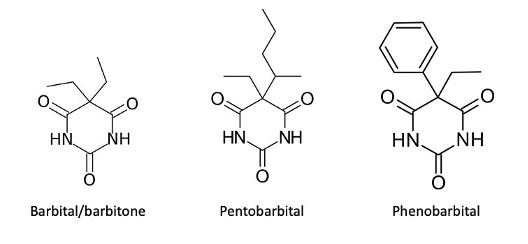
benzodiazepines ?
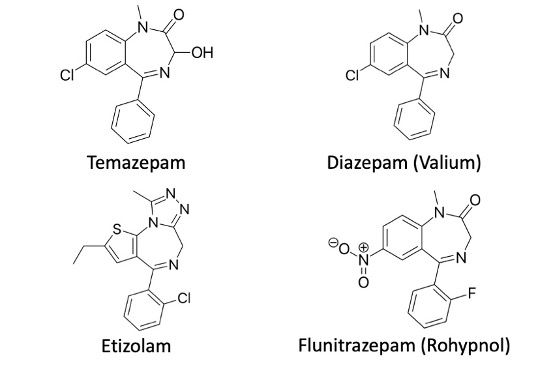
Benzodiazepine Misuse?
• Almost all prescription drugs, legally manufactured.
• Misuse via prescription theft, fraud, theft from pharmacies.
• Widely available over the internet.
Temazepam Misuse in Scotland?
• 1990s – temazepam abuse was widespread in Glasgow.
• Gel formulation known as “jellies”, mixed with heroin and injected.
• Gel blocked users’ vein and led to many amputations and deaths.
• Gel capsules banned in UK in 1995.
Drug misuse Deaths Involving Benzodiazepines:
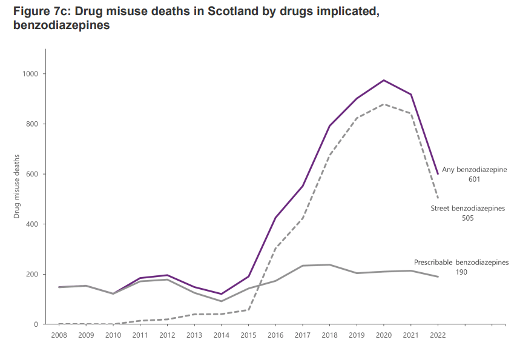
presumptive testing- barbiturates?
• Dille–Kopanyi Test for Barbiturates:
• (1) 0.1g cobalt acetate + 0.2 ml glacial acetic acid in 100 ml MeOH.
• (2) 5 ml isopropyl amine in 95 ml MeOH.
• Mix equal amounts of test material with reagents – purple colour positive for barbiturates.
• Test is specific to barbiturates but does not discriminate between barbiturates.
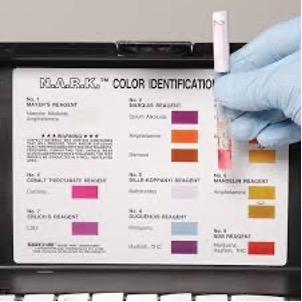
presumptive testing - benzodiazepines?
• Zimmerman Test for Benzodiazepines:
(1) 1% solution of 2,4-dinitrobenzene in MeOH.
(2) 15% aqueous KOH solution.
• Mix test material with 1 drop of each reagent:
A red-pink colour suggests the presence of benzodiazepines.
Other materials may also give a positive result.
• As with all presumptive tests, positives and negative controls should be used along with the test materials.
GC-MS Barbiturates?
• Highly polar, may need derivatisation, e.g. methylation of NH groups:

Phenobarbital MS:
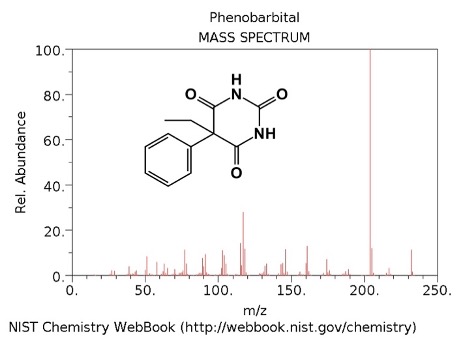
Phenobarbitone fragmentation
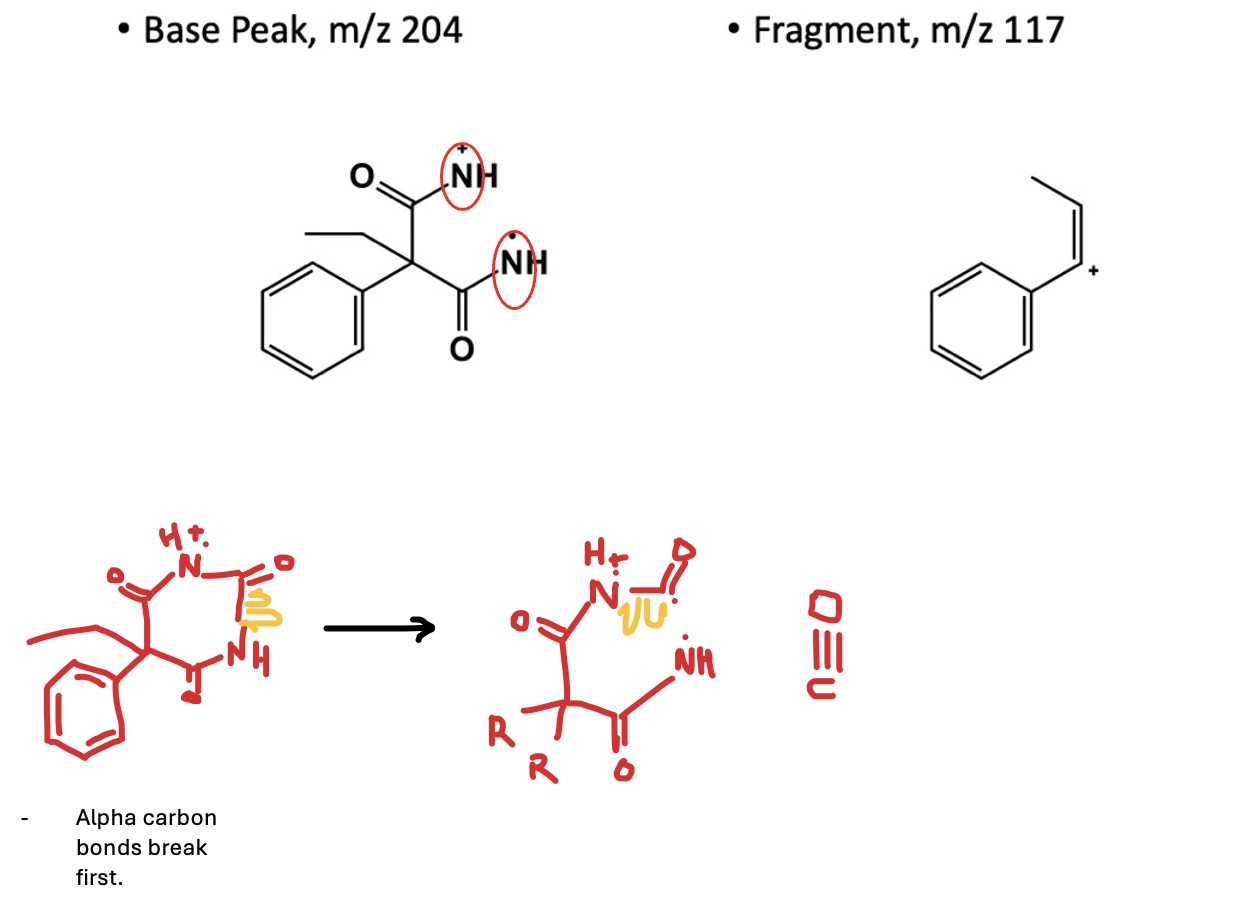
explain the determination of Phenobarbital ?
• Method of choice is HPLC.
• Conditions:
• Bio Sil HL C18 column, 5 mm, 250 x 4.6 mm.
• Mobile phase acetonitrile/water (25/75 % v/v) adjusted to pH 2.5 with H3PO3.
• Flow rate 2 ml/min.
• UV (diode array) detection @ 240 nm.
explain qauntitative measurement of Phenobarbital?
• A tablet is thought to contain 20–30 mg phenobarbital.
• Linear range of calibration 0.004–0.032 mg/ml.
• Outline a sample preparation procedure for this analysis.
explain the sample preparation of Phenobarbital?
• Assume 1 tablet contains 30 mg phenobarbital:
30 mg in 100 ml = 0.30 mg ml-1
– out with calibration range.
Dilute 1:10 to give 0.03 mg ml-1
– within calibration range.
• Sample Preparation:
• Record the individual weights of 10 tablets, calculate the mean weight, crush the 10 tablets together.
• Weigh the mean tablet weight of crushed tablet, dissolve in 80 ml mobile phase in ultrasonic bath, filter into 100 ml volumetric flask and make up with mobile phase.
• Pipette 1 ml into 10 ml volumetric flask, make up with mobile phase.
Quantitative Analysis example worked out:
• Calibration gives:
y = 895x + 0.01
Peak Area of sample = 20.85
therefore, x = 0.023 mg ml-1
• Dilution factor x 10,
Concentration = 0.230 mg ml-1
• Therefore, solution contains 23 mg per 100 ml equivalent to 23 mg per tablet.
Benzodiazepines
case studies:
case study Flunitrazepam
• Flunitrazepam (Rohypnol) available on prescription.
• Gained notoriety in drug-facilitated sexual assault and robbery when given in a spiked drink.
• Sedative-hypnotic effect – short-term amnesia.
• Rapid onset of action and short half-life (3 hours).
• Has medical uses, pharmaceutical companies now incorporate a blue dye to make it easier to detect.
However, that is not fool proof as many drinks are themselves highly coloured and the colour might be hard to detect in a dark night-club.
drug facilitated assault?
• In 2004, a woman was convicted in the UK of robbery after drugging her male victims with Rohypnol.
• She met the men in bars, accompanied them home and spiked red wine with Rohypnol.
• Traces were found in the victims’ blood and urine, which led to her being caught.
• Two men reported the crime, but police believe there were more victims who were too embarrassed to come forward.
This case was one of the first of this type to actually result in a conviction.
News story about the case: https://www.theguardian.com/uk/2004/dec/17/ukcrime.stevenmorris1
Flunitrazepam Metbolites?
• Primary metabolite is 7-aminoflunitrazepam.
The short half-life of flunitrazepam is important in forensic cases because it is rapidly metabolised to 7-aminoflunitrazepam. This means that if you look for the parent drug only, you would be unlikely to find it if some time has passed between the victim ingesting the drug and a sample being taken.
• Flunitrazepam rapidly converted to 7-aminoflunitrazepam (7-AF).
• 7-AF detected in urine up to 72 hours after ingestion, flunitrazepam undetected.
• Require fast, sensitive method of detecting flunitrazepam and 7-AF.
• LC–MS requires no derivatisation step – used to confirm identity of sample components.

flunitrazepam mass spectrum:
This is the mass spectrum of flunitrazepam which shows a molecular ion at m/z 314 and a fragment ion at m/z 284.
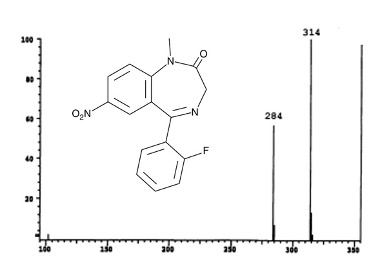
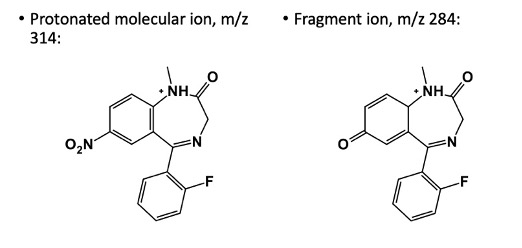
The difference between the protonated molecular ion and the fragment ion is at the position of the original NO2group.
7-Aminoflunitrazepam MS:
The mass spectrum of the metabolite, 7-AF show a molecular ion at m/z 284, the same mass as the fragment ion for flunitrazepam. However, this is not the same compound – again, the difference is at the NH2 group.
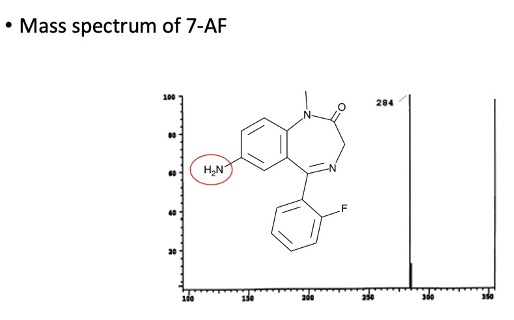
Flunitrazepam Chromatogram:
• Extracted ion chromatogram of serum extract show good resolution of flunitrazepam and &-AF:
•Selected ion monitoring used for increased sensitivity and quantitation.
Although the metabolite and the fragment ion have the same mass, they are separated by the chromatography. These extracted ion chromatograms show good resolution of the flunitrazepam and the metabolite.

Flunitrazepam detection
• Results following ingestion of 1 mg oral dose of flunitrazepam:
This table is taken from a study where a volunteer took 1 mg of flunitrazapem and blood and urine samples were taken at various time periods up to 60 hours.
The results show that flunitrazepam is not present in either blood or urine only 12 hours after ingestion. This is quite a short time period for someone to perhaps realise that they have been drugged and report either to the police or go to hospital.
The metabolite was found in blood after 12 hours and in urine up to 60 hours. This example illustrates the importance of analysing the correct sample as well as looking for the metabolite.
Testing a blood or urine sample for the parent drug only would result in a false negative.
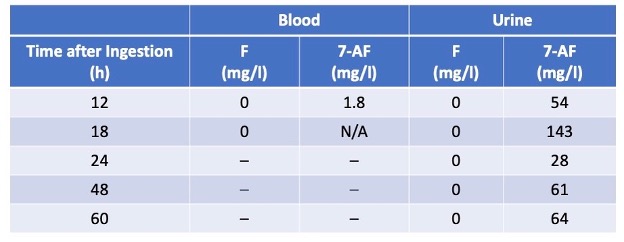
case study - Criminal Poisoning of Commuters
• 10–15 patients per day admitted to hospital in Dhaka suffering from benzodiazepine overdose.
• Most had travelled on public transport and had bought or accepted food or drink.
• All had been robbed of personal property, in some cases, all they owned.
This case study is from the city of Dhaka in Bangladesh.
Over a few months, between 10-15 patients a day were being admitted to the central hospital suffering from benzodiazepine overdose.
Most had travelled on public transport and had either bought or accepted food or drink.
Many were found unconscious in the central bus station and were given prompt medical help. None had actually been assaulted but all had been robbed of personal property.
In some cases, people were travelling to the city to find work and were robbed of all they owned.
case study,
• Urine samples collected within 12 hrs of admission.
• Tested by:
• Fluorescence polarization immunoassay.
• LC–MS.
• Also tested for alcohol by headspace GC.
Because the victims were mostly given early medical treatment, urine samples could be collected and tested.
The hospital used an immunoassay test which can identify benzodiazepines but is not as specific or sensitive as LC-MS.
Samples were sent off for analysis by LC-MS and were also tested for alcohol by the usual headspace GC method.
case study,
• Urine samples analysed by LC–MS.
• In a set of 15 victims, all tested positive for lorazepam.
The slide shows the total ion chromatogram of the benzodiazepines detected.
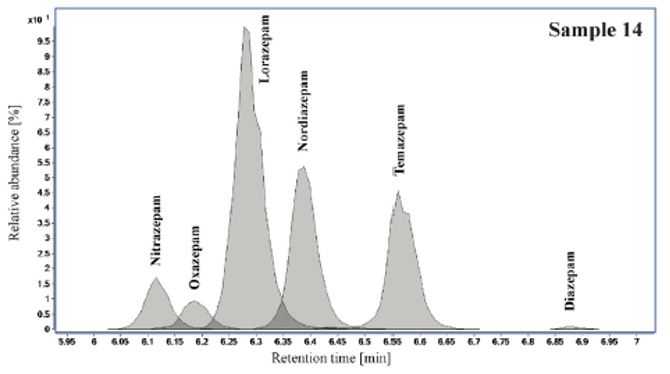
case study,
• In 8 cases tested by LC–MS, the lorazepam concentration was below the lod for immunoassay – would have given false negative results.
• Nitrazepam & Diazepam also found in 6 cases.
• Only 1 sample tested positive for alcohol.
So, what is going on?
• Bangladesh study – all victims found in public places and hospitalised within short time period.
• Recreational drug use is very low because of economic and religious reasons.
• Benzodiazepine poisoning of commuters deliberately carried out by criminal gangs for purpose of robbery.
detecting drug facilitates assault in the UK
• Confirmation of drug facilitated assault in industrialised nations difficult to prove against a background of voluntary drug use and alcohol consumption.
• UK study of 1014 alleged assaults over 3-year period, – only 21 cases confirmed deliberate spiking.
• True incidence may be higher,– many victims do not report the incident or late reporting means drugs are undetectable.
The reason for considering this case is to compare with what happens in the UK and much of western society, where there is a strong culture of alcohol consumption and recreational drug use.
This means that when a drug is administered to commit a crime, it is very difficult to obtain reliable forensic evidence – the spiked drink is usually not available.
victim?
• Probably drinking alcohol – may have poor recollection of events leading up to the “spiking”.
• May have knowingly consumed other drugs – reluctant to report assault
• May not report assault until days after the event took place
• May be considered unreliable witness
benzodiazepines?
• Active in low doses.
• Chemically unstable.
• Give amnesic effects.
• Rapidly metabolised and excreted.
• Analysis method must be capable of detecting parent drug and metabolite at low concentrations.
case study,
outcome:
• In January 2020, Reynhard Sinaga was found guilty of sexual offences against 48 men.
• He lured them from outside Manchester clubs to his flat where he drugged them with GHB.
• Police have video evidence that he targeted at least 190 victims but many may be unaware of what happened or unwilling to report.